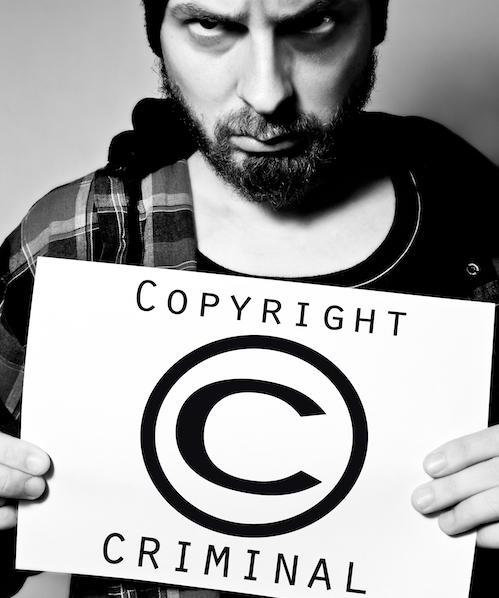“One of the first and easiest steps any photographer can take in protecting images against photo theft is to lower the resolution and size of their photos when posting them online.”

Over the past two decades, photographers and image creators have been undergoing an immense yet practically unnoticed battle: the battle against online image theft.
Despite the fact that in most countries, photographers own the copyright from the moment they take a photo, their copyright privileges and income have decreased to unprecedentedly low levels. In fact, it’s estimated that some 2.5 billion photos are stolen every day.
For image creators who rely largely on money coming in from their copyrighted photos, these thefts can have a devastating effect on their yearly incomes. With so many images constantly being stolen, it’s easy for creators to feel like there’s no way to protect their photos or fight back against image theft.
However, despite the fact that protecting photos can be a massive undertaking, it’s certainly not impossible to stand your ground. With the advent of new image-crawling technologies and editing solutions, it’s becoming easier to prevent and overcome image theft. By following the tips below, you’ll ensure you’re doing everything in your means to protect your work.
Protecting images from photo theft through resolution, size and watermarks
One of the first and easiest steps any photographer can take in protecting images against photo theft is to lower the resolution and size of their photos when posting them online. The Copytrack Global Infringement Report found that photos with a 16:9 aspect ratio were most likely to be stolen, while the most popular resolution for image theft in 2018 was Full HD, or 1920 x 1080 pixels.
If you’re looking for an easy way to dissuade potential image thieves, uploading your images in an aspect ratio and resolution other than Full HD would be a good start. Photographers can also use semi-transparent or invisible watermarks to protect their work. The last thing most thieves want to do is take the time and effort to remove watermarks, rather than just find a different, non-watermarked image. If you do watermark your images, it’s important to make sure that your watermarks are prominent enough that they aren’t easy to remove.
The downside of watermarking, of course, is that your pictures won’t look as good. However, Photoshop has come up with an interesting solution: The Digimarc Barcode, or the invisible watermark. These invisible watermarks act as digital forms of copyright protection for images by embedding copyright information directly into images themselves while keeping the information invisible to the naked eye. This becomes a win-win for image owners, as they can upload their photos without needing a glaring watermark. While an invisible watermark won’t always be enough to prevent image theft, it will make it a lot easier to track down images once they’ve been stolen.
Make it overly apparent that your work is copyrighted
Another common practice is to make it loud and clear that your images are copyrighted on your website, using language throughout the site that notes all work is copyrighted. If special licensing is needed to use your images, make sure that it is clearly displayed so every online user can see that your photos are not allowed to be taken for free.
It can also be helpful to include a clear warning which states that you will chase down illegal uses of your photos — and that it can lead to serious fines for the culprits. In most countries, the starting point for fines is the cost of the original license per image — and in some cases, extra charges can be added on top. For example, if someone were to use one of your images on their business website, you could say that the business owner profited from the image and ask for a percentage of those profits to be added to the fine, plus legal and court costs.
While letting it be known that your work is copyrighted won’t necessarily guarantee total safety from image theft, it will help inform users who might have otherwise stolen your images accidentally. And, you never know — clearly displaying your requirements for use could even lead to extra licensing of your images.
Another easy step to take is to name the copyright owner and source in the image itself. For example, by adding this information on the lower margin of the photo, it’s made instantly clear who owns the image rights and where the image comes from. This holds true even when your images are found somewhere other than your website, making it clear once again that these images are not free for anyone to use.
Registering for copyright and post-licensing stolen images
Although this method doesn’t guarantee protection from the act of image theft itself, signing up for copyright protection is helpful for when you need to back up your copyright claim in court. Getting your images protected by a district court or notary will equip you with the evidence needed to prove that it is in fact you who holds the copyright for a specific image. Once you register an image, you’ll receive a certificate that clearly proves you are the rightful copyright holder.
It’s simple enough to get a copyright certificate: Traditionally, any photographer could always go to a site like copyright.gov to protect their images. However, in 2019, there are new ways of getting this done, including using blockchain technology. For example, copyright registration companies like Concensum offer a sophisticated option for those who want to register a copyright for their images worldwide. Their international intellectual property registry is designed specifically for photographers who want to protect their photos, using blockchain technology to save uploaded photos securely with information about the copyright owner and the licensing rights.
As any photographer already knows, it can be next to impossible to upload images without having them stolen at one point or another. That’s why one of the most crucial things you can do to protect your work is to make sure you have a plan of action for when you become a victim of online image theft.
Fortunately, there is a way to get the compensation you rightfully deserve for your stolen photos. To find out if someone has been using your images online without your permission, you can use an array of services, such as Google’s reverse image search, or image-crawling solutions that constantly search and track your images so you can be alerted as soon as a thief uses your images illegally. Once you know when your images are being used without permission, you can take legal action to make claims for your stolen images, getting money back that you rightfully deserve.
Unfortunately, there’s still no “one-size-fits-all” solution when it comes to protecting your images online. However, by combining a mixture of some or all of the solutions listed above, you can finally fight back against image thieves and start taking back what’s yours.

![[IPWatchdog Logo]](https://ipwatchdog.com/wp-content/themes/IPWatchdog%20-%202023/assets/images/temp/logo-small@2x.png)

![[[Advertisement]]](https://ipwatchdog.com/wp-content/uploads/2024/04/Patent-Litigation-2024-banner-938x313-1.jpeg)
![[Advertisement]](https://ipwatchdog.com/wp-content/uploads/2024/04/UnitedLex-May-2-2024-sidebar-700x500-1.jpg)
![[Advertisement]](https://ipwatchdog.com/wp-content/uploads/2024/04/Artificial-Intelligence-2024-REPLAY-sidebar-700x500-corrected.jpg)
![[Advertisement]](https://ipwatchdog.com/wp-content/uploads/2024/04/Patent-Litigation-Masters-2024-sidebar-700x500-1.jpg)

![[Advertisement]](https://ipwatchdog.com/wp-content/uploads/2021/12/WEBINAR-336-x-280-px.png)
![[Advertisement]](https://ipwatchdog.com/wp-content/uploads/2021/12/2021-Patent-Practice-on-Demand-recorded-Feb-2021-336-x-280.jpg)
![[Advertisement]](https://ipwatchdog.com/wp-content/uploads/2021/12/Ad-4-The-Invent-Patent-System™.png)






Join the Discussion
4 comments so far.
Anon
July 28, 2019 10:06 amQuite apart from any of the merits of the article (in other words, please pardon the tangent thought), I find it interesting that one of the suggestions is to only share a version of a work in a “messy” version.
This of course — whether the author was aware of this or not — presents a type of historical flashback. In an era long ago (and that will leave millennials scratching their heads), blank cassette tapes were available for ordinary people to make their own “albums.” (Perhaps I can appeal to millennials with a Peter Quill/Guardians of the Galaxy tie-in).
A factual predicate in how that “business model” proliferated was the notion that such “recorded off of radio” collections were of then-necessary much poorer quality.
But as I have said, times have changed and the business model of dealing with digital goods makes most all replications (even, or especially replications by your judgement-proof individuals) to be of perfect quality (that is, perfect quality of the source digital good).
What we actually have here from an historical perspective is a clash of an old-world business model being eclipsed with a changing nature of the goods that make up the business.
Note as well — but definitely separate from the topic here — that home replication and improved ‘digitization’ has its mirror issues for the patent world and the advent of additive manufacturing techniques.
So, from each of an artistic angle, an historical appreciation angle, and a business model angle, the ‘answer’ of ‘just post crappier images’ is rather unappealing.
super CMI fan
July 27, 2019 08:34 pmExcept for the copyright.gov link, my computer’s malware software blocked all of Marcus Schmitt’s highlighted article links as being “phishing” websites!
super CMI fan
July 27, 2019 06:10 amCopyTrack, Pixsy, ImageRights, and other image-tracking services, issue demand letters to unlicensed users, hope they settle, and move on to the next infringer.
For their business models to work, they have to settle lots of infringements and relatively quickly; they’re not really setup to litigate. I’m betting that if you have a timely registered copyright in-hand, your copyright litigator could get you MUCH, MUCH larger settlements when going after US-based infringers.
The article’ author, Marcus Schmitt writes, “Traditionally, any photographer could always go to a site like copyright.gov [the United States Copyright Office] to protect their images. However, in 2019, there are new ways of getting this done, including using blockchain technology. For example, copyright registration companies like Concensum offer a sophisticated option for those who want to register a copyright for their images worldwide.”
Using blockchain, the poor man’s copyright, Concensum, or other types of “times-stamping” tools are NOT substitutes to officially registering photo copyright claims with the US Copyright Office (USCO). None of those services provide authors with presumptive proof of a valid copyright when pursuing US infringements.
Though international photographers who reside in Berne Convention countries are exempt from obtaining a US copyright Certificate of Registration to have standing, they and US-based photographers can only pursue actual money damages (typically the licensing fee that tend to be low-dollar amounts) and the disgorgement of profits the infringer made (if any!) when their photographs are not timely registered.
I’m not saying US-based photographers should not use CopyTrack’s services; it might be a good option to pursue international infringements, but not so good for going after infringers inside the US.
jacek
July 26, 2019 02:18 pmNice and Dandy but legally there is not international Copyright registration. It is nice tool to have your image tracked and I think it can be used to track infringements in countries you have any type of IP registered or applied for. I think this web site creates confusion among non lawyers that it is possible to have international copyright. Wishful but not real.